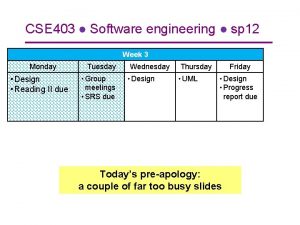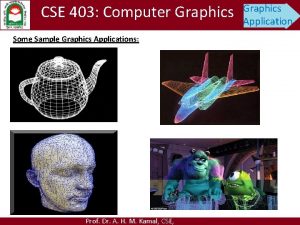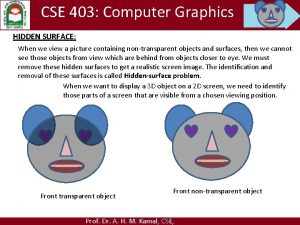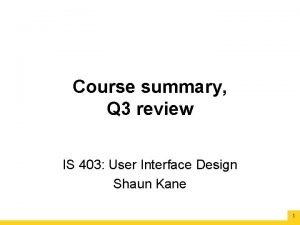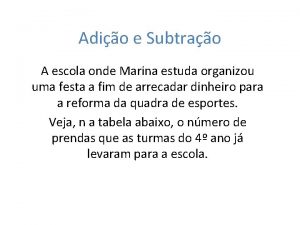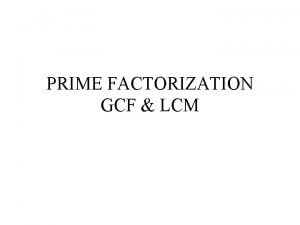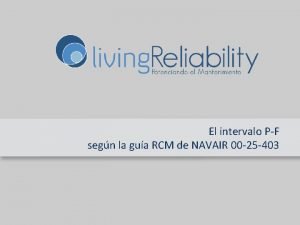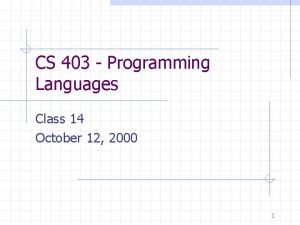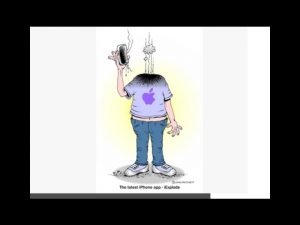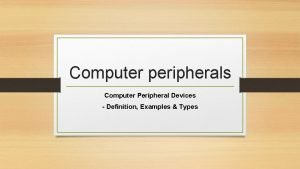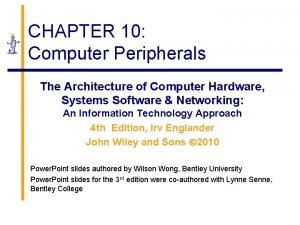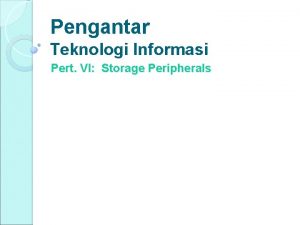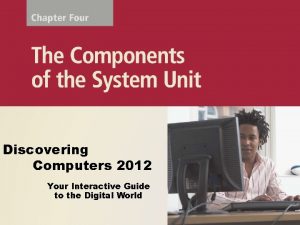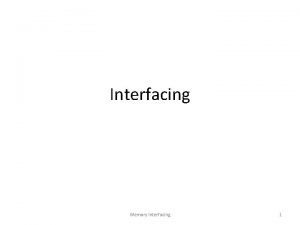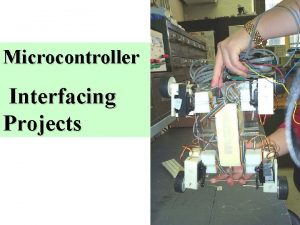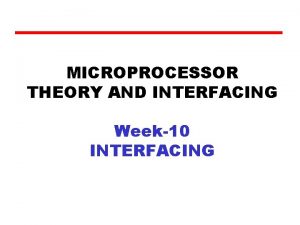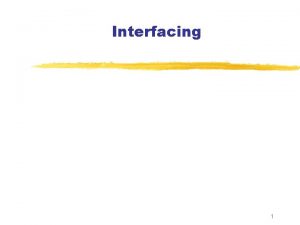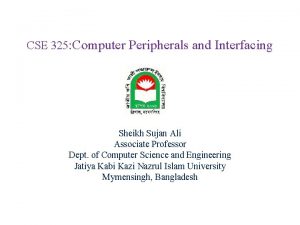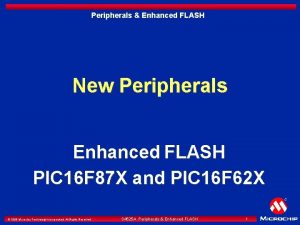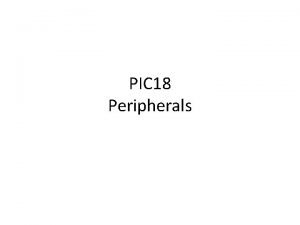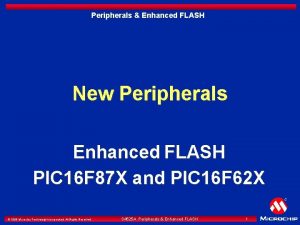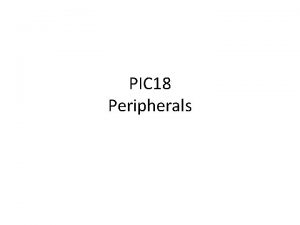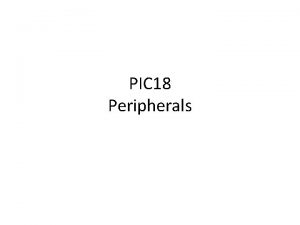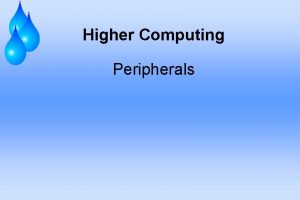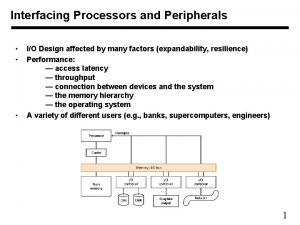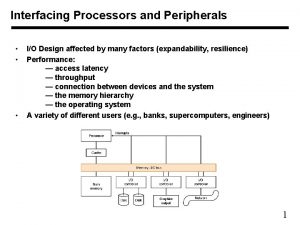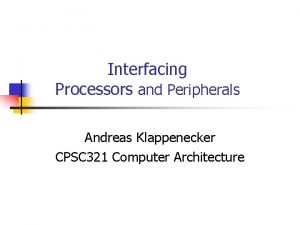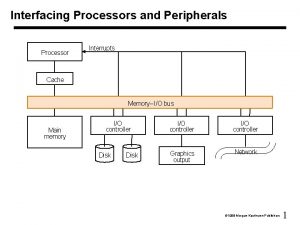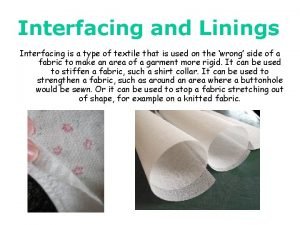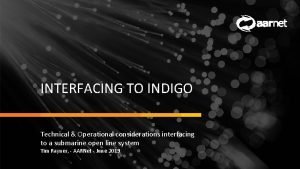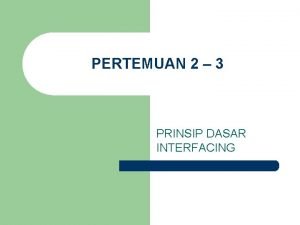CSE 403 Peripherals Interfacing Lecture 1 Introduction to




















- Slides: 20

CSE– 403 Peripherals & Interfacing Lecture - 1 Introduction to Peripherals & Interfacing Albab Hossain (Maruf) Lecturer, Department of CSE DIU 03 January 2022 CSE-403 1

Course Materials • Text Book: – Microprocessors and Interfacing: Programming and Hardware, Author: Douglas V. Hall – Microprocessor Architecture, Programming and Applications with the 8085 Author: Ramesh Gaonkor • Additional Support: – Class Lecture Slides 03 January 2022 CSE-403 2

Today’s Outline: • • Microprocessor & Microcontroller Overview of Microcomputer System Bus Registers 03 January 2022 CSE-403 3

Does Earlier Knowledge Require ? ? • You should have the knowledge about – • Microprocessor and • Microcontroller (in detail will be covered in this course). • Basics of “Digital Logic Design” course. • Should we learn from the very basic? Most of them already done !! Right? 03 January 2022 CSE-403 4

Earlier Terminologies!! Microprocessor & Microcontroller: • Two terms to be used mostly in this course – Microprocessor – Microcontroller • Microprocessor A microprocessor (abbreviated as μP or u. P) is a Silicon Chip that contains an electronic central processing unit (CPU). In the world u. P or CPU used interchangeably, which is made from miniaturized transistors and other circuit elements on a single semiconductor integrated circuit (IC). Examples: Intel Pentium, Intel 80 x 86, 8085 etc. 03 January 2022 CSE-403 5

Earlier Terminologies!! (Cont…) • Microcontroller – Dedicated to perform one task. – Integrates the memory and other features of a microprocessor. • A microcontroller is the integration of • Microprocessor • Memory – ROM types – commonly flash PROM – RAM – Static ram • Peripherals – – Parallel input and output Serial input and output (UART, USART, etc. ) Analogue to digital convertors Timers and Counters • Examples: ATmega 8 A, Atmega 32 A, ATmega 328 etc. 03 January 2022 CSE-403 6

New Terminologies !! Peripherals and Interfaces : • Peripherals Computer peripherals such as disk drives, display, keyboard, printers etc. work in different ways and linking a peripheral to the processor is a difficult task. • Interfaces An interface is the hardware and software needed between a processor and a peripheral device in order to compensate for differences in their operating characteristics. 03 January 2022 CSE-403 7

Revision of Concepts !! Overview of Micro-Computer Structure: A microcomputer has three basic blocks: a central processing unit (CPU), a memory unit, and an input/output (I/O) unit. • The CPU(microprocessor) executes all the instructions and performs arithmetic and logic operations on data. • A memory unit stores both data and instructions. The memory section typically contains ROM and RAM chips. • A system bus (comprised of several wires) connects these blocks – Address Bus, Data Bus and Control Bus 03 January 2022 CSE-403 8

Revision of Concepts !! System Bus : The microcomputer’s system bus contains three buses, address, data, and control bus – When a memory or an I/O chip receives data from the microprocessor, it is called a WRITE operation, and data is written into a selected memory location or an I/O port (register). – �When a memory or an I/O chip sends data to the microprocessor, it is called a READ operation, and data is read from a selected memory location or an I/O port. 03 January 2022 CSE-403 9

Revision of Concepts !! The Address Bus : – It is a Unidirectional bus. – Information transfer takes place in only one direction, from the microprocessor to the memory or I/O elements. – Typically 20 to 32 bits long. – The size of the address bus determines the total number of memory addresses available 03 January 2022 CSE-403 10

Revision of Concepts !! The Data Bus – It is a bidirectional bus – Data can flow in both directions, that is, to or from the microprocessor. – The size of the data bus varies from one microprocessor to another. – Usually matches the word length of the microprocessor – Usually a multiple of 8 – We talk of 8 -bit, 16 -bit , 32 -bit and 64 -bit processors which refers to the normal word length of the microprocessor 03 January 2022 CSE-403 11

Revision of Concepts !! The Control Bus – It consists of a number of signals that are used to synchronize operation of the individual microcomputer elements. – Consists of potentially many signals. Typically: – Read – Write – Could be single signal - Read/not. Write line – Interrupt control – Bus control signals for DMA (Direct Memory Access) 03 January 2022 CSE-403 12

Revision of Concepts !! The Control Bus – It consists of a number of signals that are used to synchronize operation of the individual microcomputer elements. – Consists of potentially many signals. Typically: – Read – Write – Could be single signal - Read/not. Write line – Interrupt control – Bus control signals for DMA (Direct Memory Access) 03 January 2022 CSE-403 13

Revision of Concepts !! Registers : • The number, size, and types of registers vary from one microprocessor to another. • There are four basic microprocessor registers: – – Instruction register Program counter Memory address register Accumulator 03 January 2022 CSE-403 14

Revision of Concepts !! Register - Instruction Register – The instruction register stores instructions. – The word size of the microprocessor determines the size of the instruction register. – For example, a 32 -bit microprocessor has a 32 -bit instruction register. 03 January 2022 CSE-403 15

Revision of Concepts !! Register – Program Counter – The program counter contains the address of the instruction or operation code (op-code). – The program counter normally contains the address of the next instruction to be executed. – The size of the program counter is determined by the size of the address bus. 03 January 2022 CSE-403 16

Revision of Concepts !! Register – Accumulator – It is a General Purpose Register (GPR). – For an 8 -bit microprocessor, the general-purpose register is called the accumulator. – It stores the result after most ALU operations. – These 8 -bit microprocessors have instructions to shift or rotate the accumulator one bit to the right or left through the carry flag. – In 16 - and 32 -bit microprocessors the accumulator is replaced by a GPR. – Any GPR can be used as an accumulator. 03 January 2022 CSE-403 17

Revision of Concepts !! Register – Memory Address Register – The memory address register contains the address of data. – The microprocessor uses the address, which is stored in the memory address register, as a direct pointer to memory. – The contents of the address is the actual data that is being transferred. 03 January 2022 CSE-403 18

03 January 2022 CSE-403 19

03 January 2022 CSE-403 20
 Cse 403
Cse 403 Cse 403
Cse 403 Cse 403
Cse 403 Po 403
Po 403 Low voltage
Low voltage Envirobond 403
Envirobond 403 403
403 Quantas prendas a turma 403 já levou para a escola
Quantas prendas a turma 403 já levou para a escola 225 factor tree
225 factor tree 403 b 9 church plans
403 b 9 church plans Intervalo p-f
Intervalo p-f Subprogram c++
Subprogram c++ 01:640:244 lecture notes - lecture 15: plat, idah, farad
01:640:244 lecture notes - lecture 15: plat, idah, farad Storage peripherals
Storage peripherals Peripheral devices
Peripheral devices Computer peripherals storage devices
Computer peripherals storage devices Storage peripherals
Storage peripherals Can connect up to 127 different peripherals
Can connect up to 127 different peripherals Introduction to biochemistry lecture notes
Introduction to biochemistry lecture notes Introduction to psychology lecture
Introduction to psychology lecture Introduction to algorithms lecture notes
Introduction to algorithms lecture notes
